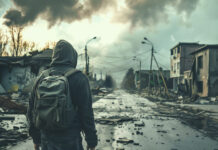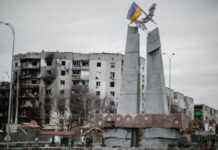After a brief pause following the election, nuclear war seems to have become a hot topic of conversation yet again.
In addition to multiple YouTube videos, we have the story What if a Nuke Detonated in Los Angeles, which was pinned at the top of Zero Hedge on Thursday night when I wrote this post. Then there is an article in the New York Post earlier in the week, Some States are Safer than Others in a Nuclear Attack, which shows a map that ran in Scientific American one year ago.
A Tale of Two Wars
The Zero Hedge article focuses on the amount of people who would die in the blast radius if a 20 megaton weapon hit a list of American’s biggest cities: Washington, New York, Chicago, Houston, Phoenix, Philadelphia, San Antonio, San Diego, and Dallas.
The article in the Post and the info from Scientific American emphasizes what would happen if the enemy—which we assume is Russia—targets the land-based intercontinental ballistic missiles (ICBMs) in Colorado, Wyoming, Nebraska, Montana and North Dakota. It appears the Post is giving the worst-case scenario. If you read the original SA article, you will find the map the Post ran is highly misleading. The course of fallout following an attack on our ICBM bases would vary widely depending on the prevailing winds. The map in the Post is a composite for a full year, not a single attack.
While Scientific American is less alarmist about the map than the Post, they highlight the danger of nuclear winter. Many experts would tell you that the risk—or at least the length—of nuclear winter is exaggerated and based on bad science. With any luck, we will never know who is right.
A Third Scenario
In my opinion, neither Zero Hedge nor Scientific American is correct. My best guess is that the enemy would attack the ICBMs and a number of cities and other critical targets. Here is what I would do in their shoes:
- A dozen missiles for Washington, D.C., Northern Virginia, and Baltimore to knock out the White House and the Pentagon, creating a leadership vacuum. Other targets would include Joint Base Andrews, Quantico, and other nearby military bases, the CIA and the NSA, plus the Port of Baltimore. Damage would also be done to the data centers and power grid in that area, knocking out large chunks of the country’s Internet and AI capabilities.
- Six missiles for New York City to wipe out Wall Street and disrupt the country’s finances, take out the port of New York, and to cause a great deal of death and a massive refugee crisis.
- Several missiles for Houston, specifically the Houston ship channel, oil refineries, chemical plants, and natural gas processing facilities. Rebuilding the country will be much harder without the fuel, polymers, and chemicals that come from this part of the country.
- Several missile strikes along the Louisiana coast, for many of the same reasons. Of course, hitting New Orleans and preventing the use of the Mississippi River to transport goods will be an important goal worthy of multiple missiles.
- The only reason to target Los Angeles would be to take out the port of Los Angeles and the Port of Long Beach. Rather than hit San Diego, I would hit Silicon Valley and Seattle, Washington, to knock out the foundation of America’s high-tech industry.
- Other secondary targets would include ports where aircraft carriers or nuclear submarines are based, airbases that have nuclear-weapon capable bombers and fighters, and large, strategic military commands.
- Tertiary targets would be nuclear power plants, steel mills, microchip foundries, and manufacturing facilities for companies like Boeing and Lockheed-Martin.
- I’d also hit SpaceX and maybe try to take out Elon Musk because he looks like a guy who could be critical to the war effort if left alive.
Of course, I’m no expert and the enemy has its own plans. They may nuke a city in Ukraine or a military base in Poland rather than risk an all-out nuclear war. That’s a more survivable scenario for all of us.
How to Prep
From a prepping standpoint, if you live near a target zone, you might be in trouble. If you are too close to a target, you will be dead unless you are in a blast shelter or well underground. Once the missile strikes are over, you need to protect yourself from fallout for the short term and then starvation and other survivors in the long run. That is where your preps come into play.
Here is what you need to ask yourself:
- Do you live in a potential target area? If so, how far away is the target? hat are your odds of surviving the initial strike?
- Do you have a fallouts shelter or can you rapidly get underground or surrounded by a thick wall and ceiling of dirt, concrete, bricks, or other heavy material? Even a basement can improve your odds by cutting the amount of radiation that reaches you.
- If the fallout doesn’t kill you, do you have sufficient food and water to survive for a couple of weeks or a month under these conditions?
- How long will your stored food last? What will you do if nuclear winter lasts two or three years?

Surviving a nuclear war will not be easy, especially in the northern hemisphere where the bulk of the weapons will strike. Think of it as the ultimate prepper test and make it your goal.
Here is some valuable reading: You will Survive Doomsday by Bruce Beach.







